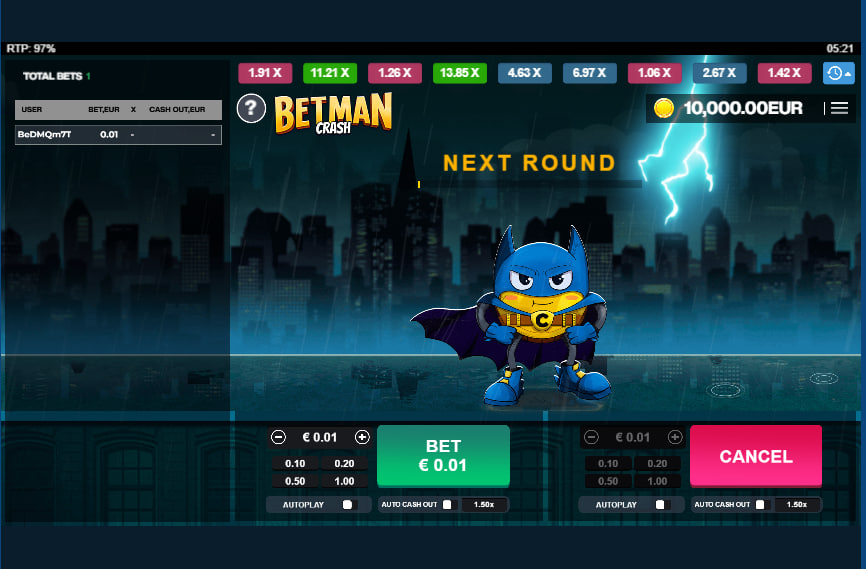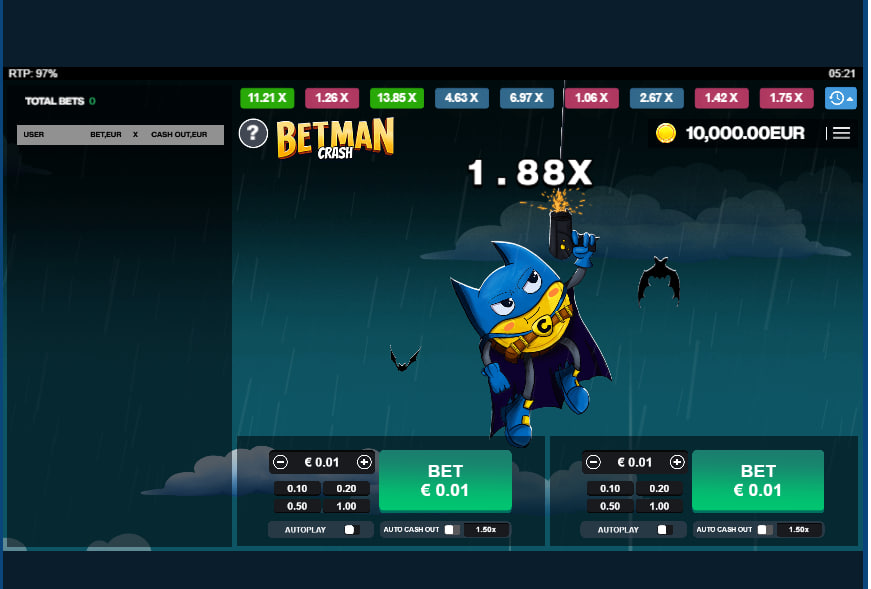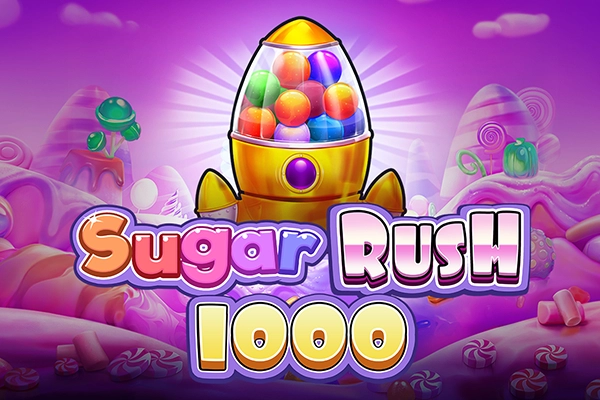Caleta Gaming’s Betman Crash offers a compelling, skill-based alternative to conventional online slots. The game’s core centers on a single, ascending multiplier, challenging players to secure their winnings before a randomly determined crash point. Its visual theme is a lighthearted superhero parody, creating a relaxed atmosphere that belies the tense, decision-driven nature of the gameplay. Rather than fixed volatility, this game’s risk level is entirely dictated by the player’s cash-out strategy on any given round. The standout feature is a Dual Betting System, allowing for two independent wagers and enabling advanced risk-management tactics. With a high theoretical Return to Player of 97%, the game provides a transparent framework for its mechanics. Players have direct control through Autoplay and Auto Cash Out settings, making it ideal for those who favor strategic input over passive observation. Betman Crash is structured for players who enjoy managing risk and timing in a fast-paced environment.
Caleta Gaming enters the growing field of “Crash” style games with Betman Crash, a title that forgoes traditional slot machine architecture in favor of a gameplay loop centered entirely on timing, nerve, and risk management. This game is not built on paylines or symbol combinations but on a single, ascending multiplier and the player's crucial decision of when to secure their potential winnings. The immediate impression is one of simplicity, yet the inclusion of a dual-betting system and granular auto-play controls provides a substantial layer of strategic depth. The game’s presentation is a clear and lighthearted parody of a famous caped crusader, setting a tone that contrasts with the tense, decision-driven nature of its core mechanic.
The foundational concept of Betman Crash will be familiar to enthusiasts of this genre, but Caleta Gaming’s execution warrants a close examination. It appeals directly to a player base that values direct control over in-game outcomes and enjoys a fast-paced environment where each round presents a new, independent probability challenge. It is a calculated departure from the passive experience of watching reels fall, instead demanding constant player engagement and assessment.

Core Gameplay and Strategic Systems
The central action in Betman Crash revolves around a single, perpetually increasing multiplier. At the start of each round, players have a brief window to place one or two independent wagers. Once the betting window closes, the game's hero, Betman, begins his ascent, and a multiplier value starts climbing from 1.00x. The multiplier increases at a variable pace, building suspense. The player's objective is to click the “Cash Out” button before the round abruptly ends, signified by Betman “flying away” at a randomly determined point. A successful cash-out multiplies the initial stake by the value displayed at the exact moment the button was pressed. If the round ends before the player cashes out, the entire stake for that bet is lost. This creates a tense dynamic, a constant balancing act between securing a small, consistent gain and holding out for a potentially much larger multiplier.
The game's most significant mechanical feature is its Dual Betting System. Players can place two separate bets for the same round, each with its own independent “Cash Out” button. This functionality transforms the game from a simple test of nerve into a more nuanced exercise in risk management. A common strategy enabled by this system involves dedicating one bet to a “safe” objective and the other to a “high-risk, high-reward” goal. For instance, a player might set one bet to automatically cash out at a low multiplier, such as 1.5x, effectively aiming to cover the stakes of both wagers for that round. The second bet is then free to run, allowing the player to chase a much higher multiplier without the risk of a total loss for the round. This approach allows for a level of strategic portfolio balancing that is absent in single-bet crash games.
Further enhancing player control are the Autoplay and Auto Cash Out functions. These are not merely convenience features; they are integral tools for executing a consistent strategy. Autoplay allows a player to set a base bet that is automatically placed at the beginning of each subsequent round. The more critical function is Auto Cash Out, which enables a player to pre-define a multiplier value at which the system will automatically cash out their bet. This can be set for one or both bets independently. This removes the element of human reaction time and emotional decision-making, allowing for the precise execution of a pre-determined strategy. If the precise interaction between setting a bet and activating the auto cash-out feature seems complex, you can launch the demo Betman Crash version and open the in-game help file (usually marked with an “i”) for a step-by-step visual guide from the developer. It is important to note from the game's rules that these automatic settings must be configured before the start of a round to be active for that round's duration.
Thematic Execution and Visual Design
Caleta Gaming has opted for a straightforward and recognizable theme that injects a bit of levity into the otherwise tense proceedings. The “Betman” character is an unmistakable, if cartoonish, parody of a well-known comic book hero. He is depicted as a short, determined figure in a blue and yellow costume, set against a dark, stylized city skyline. The game avoids any narrative complexity; the theme serves purely as a visual wrapper for the core mechanic. The name itself is a clever play on words that immediately communicates the game's betting-centric nature. This approach is effective, as it creates a memorable character without the need for intricate lore or distracting story elements.
The art style is clean, functional, and rendered in a 2D vector graphic format. This is a deliberate choice that prioritizes clarity over visual spectacle. The most important visual element on the screen is not the character but the large, bright, and constantly updating multiplier number. The animation is minimal but effective: Betman rises steadily, and the round concludes with a simple but clear “crash” graphic. The user interface (UI) is exceptionally well-designed for the game's fast-paced nature. The bet controls are intuitive, using simple plus and minus buttons and presets. The two large betting buttons—which change from “BET” to “CANCEL” and then to “CASH OUT”—are color-coded and positioned for easy access, a critical consideration in a game where a fraction of a second can make a difference. The entire visual package is built to serve the gameplay, ensuring that the player's focus remains squarely on the numbers and their decision.
The Mathematics of the Crash Mechanic
Unlike video slots, Betman Crash does not use reels, paylines, or symbol hierarchies. The outcome of each round is determined by a Random Number Generator (RNG) that pre-selects a crash point for the multiplier. This means that each round is an independent event, completely disconnected from the outcomes of previous or future rounds. There are no patterns to identify or “hot/cold” streaks to follow; the game is a pure test of probability and the player’s appetite for risk within a single instance. This transparency is a cornerstone of the crash game format and one of its main appeals to analytical players.
The game specifies a Return to Player (RTP) of 97%. This figure represents the theoretical percentage of all wagered money that the game will pay back to players over an extended period of play. A 97% RTP is quite high, comparing favorably to many online slots. In the context of a crash game, the RTP is influenced by the collective cash-out behavior of all players. However, what makes this genre distinct is that a player's personal volatility is entirely self-determined. Cashing out consistently at 1.05x constitutes an extremely low-volatility strategy, whereas waiting for multipliers of 50x or more represents an extremely high-volatility approach. The game does not have a fixed volatility rating; rather, it provides a platform where players dictate their own risk-to-reward ratio on a round-by-round basis. This level of player agency over the game's variance is a defining characteristic.

Distinguishing Features and Player Experience
The element that most clearly elevates Betman Crash is the dual-betting system. This feature alone provides a significant strategic advantage and a more engaging mental puzzle than its single-bet counterparts. It encourages players to think not just about a single outcome but about managing a small, two-part portfolio within each round. This can be used to hedge bets, secure profits while letting a second bet ride, or any number of other tactical combinations. It adds a compelling layer of decision-making that seasoned players will appreciate, transforming the game from a simple reaction test to a more cerebral exercise.
The player experience is fundamentally different from that of a standard slot. The engagement is active and constant. Instead of waiting for a bonus round, the player is the primary agent in every single round. The tension is not about whether a bonus will trigger, but about a personal decision: “Do I cash out now, or do I risk it for one more increment?” This creates a very different, and for some, more compelling, form of entertainment. The pace is rapid, with minimal downtime between rounds, making it suitable for short bursts of play or longer sessions of strategic testing. Caleta Gaming’s approach prioritizes functional design and direct player control, which will certainly resonate with those who find traditional slots to be too passive. While the visual presentation is modest, the mechanical depth provided by its core systems makes Betman Crash a noteworthy and well-executed entry in its genre.













